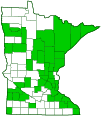silvery checkerspot
(Chlosyne nycteis)
Conservation • Description • Habitat • Ecology • Distribution • Taxonomy
|
|
|||||||||||||
Description |
Silvery checkerspot is a medium-sized brush-foot butterfly. It has a wingspan of 1½″ to 2″. The upperside of both wings is orange with a broad black margin, a black and white fringe, and other black markings. The amount of black markings is highly variable. The basal and discal areas are sometimes mostly black with a few irregular orange spots, sometimes mostly orange with irregular black spots and jagged lines. The upperside of the forewing has four irregular black patches: a subapical patch that merges with the black border; a submarginal patch near the inner margin that merges with the black border; a median patch on the leading (costal) margin; and a median patch on the inner margin. The median area in the first two cells is tawny or pale orange. In the discal area there are 5 or 6 irregular black-bordered orange spots toward the costal margin and one elongated black-bordered orange spot toward the inner margin. The subapical area has a row of 5 tawny or pale orange spots. The three nearest the apex are very small. The upperside of the hindwing no spots or faint chevron-shaped spots within the black border. There is a jagged, uninterrupted, postmedian line and a postmedian row of black spots. The spots are surrounded by orange, they do not touch the black border. At least one spots on each hindwing has a white center. The discal area is mostly black with a few orange spots. The underside of the wings are very distinctive and are the best identifying feature. The underside of the forewing is orange with a medial row of four black spots; a black apical area; a postmedian row of 5 pale orange or white spots; a submarginal band of black-rimmed pale orange or white crescent-shaped spots; an orange marginal band; and a thin black line on the outer margin. The underside of the hindwing is orange with many black-rimmed white or pale orange spots. There are several spots in the basal area; three bands of connected spots in the median area; a band of tiny postmedial spots; and an uninterrupted band of crescent-shaped submarginal spots. The marginal band is orange and there is a thin black line on the outer margin. The underside of the hindwing is tawny and pale orange with brown markings. There are three distinct bands of brown-bordered white spot; a discal band, a median band, and a submarginal band. The submarginal band is interrupted with a dark patch and a large silvery crescent. The caterpillar is up to 1 3 ⁄16″ long and black with a dusting of numerous tiny white spots. The spots are the expanded base of the hairs (seta). On the thorax and each abdominal segment there is a short, black, branched spine (scolus) in the middorsal, subdorsal, supraspiracular, spiracular, and subspiracular regions. There is often, but not always, one broad or two narrow, yellow to orange, subspiracular stripes. The head is shiny black. Mature caterpillars are found in late May and June. |
Size |
1½″ to 2″ wingspan |
Similar Species |
Habitat |
Woodland openings and edges, meadows, marshes, streamsides, roadsides. |
Ecology |
Season |
One brood: Late May to early September, but mostly early June to late July |
Behavior |
If disturbed, the caterpillar will curl up and fall to the ground. Adults fly slowly and usually no more than one foot off the ground. |
Life Cycle |
After mating in the spring the female lays rafts of up to 100 eggs on on the underside of a leaf. The young caterpillars feed and move together, skeletonizing the leaves. The third stage instar caterpillar overwinters in a “special brown skin” at the base of a host plant in a reduced metabolic state (diapause). In the spring the caterpillar resumes feeding. |
Larva Hosts |
Plants in the Asteraceae family, including coneflower (Rudbeckia), sunflower (Helianthus), aster (Symphyotrichum), and wingstem (Actinomeris alternifolia). |
Adult Food |
Flower nectar of red clover, dogbane, common milkweed, staghorn sumac, vetches, and fleabane. |
Distribution |
||
|
Sources |
|
| 7/22/2025 | ||
Occurrence |
||
Common, locally abundant |
||
Taxonomy |
|
Order |
|
Superfamily |
Papilionoidea (Butterflies) |
Family |
|
Subfamily |
Nymphalinae (Checkerspots, Anglewings, Peacocks, and Allies) |
Tribe |
Melitaeini (Checkerspots) |
Subtribe |
Chlosynina |
Genus |
Chlosyne |
Subordinate Taxa |
|
silvery checkerspot (Chlosyne nycteis drusius) silvery checkerspot (Chlosyne nycteis greyi) silvery checkerspot (Chlosyne nycteis hewitsoni) silvery checkerspot (Chlosyne nycteis lacteus) silvery checkerspot (Chlosyne nycteis nycteis) silvery checkerspot (Chlosyne nycteis pastoron) silvery checkerspot (Chlosyne nycteis reversa) |
|
Synonyms |
|
Charidryas nycteis Phyciodes millburni Phyciodes nycteis Phyciodes oenone |
|
Common Names |
|
silvery checkerspot |
|
Glossary
Costal margin
The leading edge of the forewing of insects.
Instar
The developmental stage of arthropods between each molt; in insects, the developmental stage of the larvae or nymph.
Pupa
The life stage of some insects undergoing transformation. In caterpillars, the chrysalis.
Scolus
A spiny, branched projection from a larval body wall, the branches terminating with a single stiff, hair-like or bristle-like tip.
Seta
A usually rigid bristle- or hair-like structure on butterflies and moths used to sense touch. Plural: setae.
Visitor Photos |
||
Share your photo of this insect. |
||
This button not working for you? |
||
Alfredo Colon |
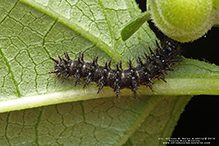 |
Kirk Nelson |
 |
MinnesotaSeasons.com Photos |
||
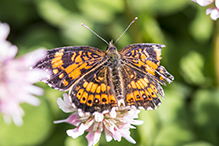 |
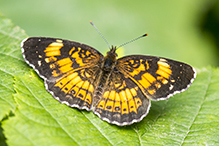 |
|
 |
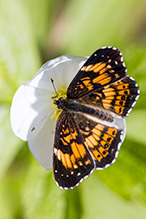 |
|
 |
 |
|
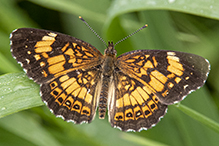 |
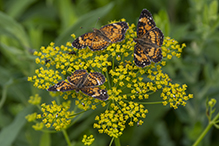 |
|
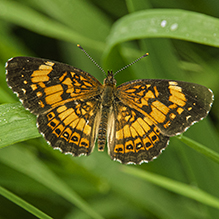 |
 |

Slideshows |
Silvery Checkerspot |

|
About
Copyright DianesDigitals Silvery Checkerspot - Chlosyne nycteis |
Silvery Checkerspot butterfly on Butterfly Milkweed |
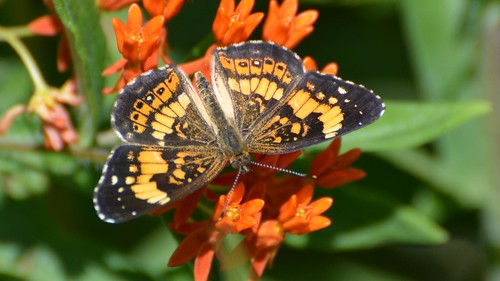
|

Visitor Videos |
||
Share your video of this insect. |
||
This button not working for you? |
||
|
Other Videos |
||
Silvery Checkerspot Butterfly Caterpillar (Nymphalidae: Chlosyne nycteis?) Locomotion |
About
Published on Jun 13, 2012 Photographed at the Turtle River State Park, North Dakota (12 June 2012). |
Silvery Checkerspot |
About
Uploaded on Nov 9, 2011 A Silvery Checkerspot nectaring on Purple Coneflower in western Howard County, Maryland. August 5, 2011 |
Close-up of a Silvery Checkerspot Butterfly |
About
Published on Jun 8, 2014 Thank you to TheGymnastic101 for correcting me here. I thought this was a Pearl Crescent, but it is actually a Silvery Checkerspot. |

Visitor Sightings |
||
Report a sighting of this insect. |
||
This button not working for you? |
||
Martha Rueter |
Location:Llindstrom, MN |
| Alfredo Colon 10/6/2019 |
Location: Woodbury, Minnesota |
 |
| Kirk Nelson 6/18/2016 |
Location: Wild River State Park |
 |
MinnesotaSeasons.com Sightings |
||

Created: 9/11/2015 Last Updated: © MinnesotaSeasons.com. All rights reserved. |
